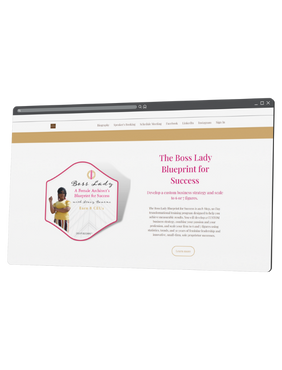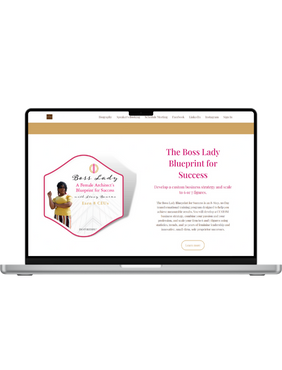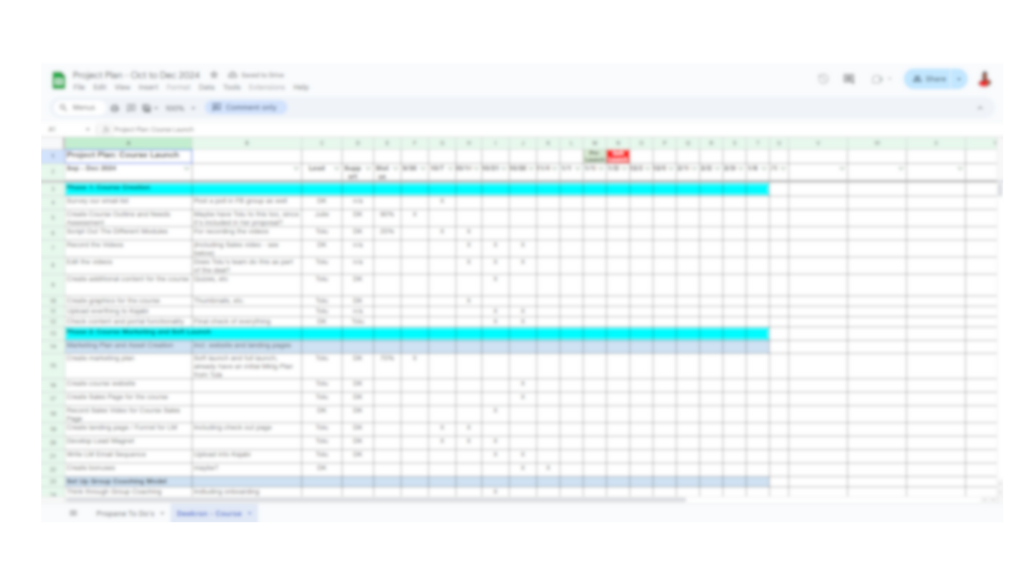
The Boss Lady Blueprint For Success
The Boss Lady Blueprint for Success is an 8-Step, 90 Day transformational training program designed to help you achieve measurable results.
Audience: “The Boss Lady Blueprint for Success” was meticulously designed for ambitious women entrepreneurs and small business owners who sought to scale their ventures to six or seven figures. The program targeted women passionate about integrating their passions with their professional goals, aspiring leaders aiming to refine their leadership skills, and small business owners looking to expand their operations. It proved ideal for self-motivated, goal-oriented individuals committed to a structured, intensive training to achieve tangible results. Participants benefited from a strategic roadmap that combined professional introduction, niche market identification, business development strategies, and financial planning, all tailored to fuel business growth and profitability while achieving work-life balance.
Responsibilities: learning design (mockups, prototype), visual design (website design, landing page design), customer journey mapping, sales funnel automation
Tools Used: Thinkific, PowerPoint, Google Docs, Canva, Mailchimp.t

The Problem and Solution
The Problem:
From my perspective as an instructional designer, “The Boss Lady Blueprint for Success” presented several potential concerns for clients. Firstly, the sheer volume of content could be overwhelming, making it difficult for participants to keep pace and retain information. Customising business strategies for each participant required personalised guidance that posed logistical challenges. Additionally, maintaining engagement and accountability over 90 days was a significant concern, as clients could lose motivation or struggle with consistency. Combining personal passion with practical business strategies proved to be tricky for many, and translating theoretical knowledge into actionable steps that yield measurable results was a common hurdle.
A professional concern I foresaw was the scalability of providing consistent, high-quality support to all participants. With elements like one-on-one sessions, weekly group coaching, and continuous feedback, there was a risk of spreading resources too thin, potentially affecting the overall quality and effectiveness of the program.
The Solution:
To address these issues, “The Boss Lady Blueprint for Success” was meticulously designed with a structured, manageable approach to learning. The program included a strategic blend of professional introduction, niche market identification, business development strategies, and financial planning, tailored to fuel business growth and profitability. We ensured personalized support through one-on-one sessions, weekly group coaching, and continuous feedback, so each participant received tailored guidance. By incorporating industry statistics, personal development stories, and practical deliverables, we equipped participants with the tools and knowledge needed to scale their businesses. The program maintained engagement and accountability with a clear roadmap and consistent support, ultimately helping participants achieve their financial milestones while maintaining a harmonious work-life balance.
My Process
Thinkific: Course Creation and Management
Thinkific is my go-to platform for developing and managing online courses. I use it to create a structured learning environment where participants can access lessons, quizzes, assignments, and additional resources. The platform allows me to upload multimedia content, organize modules logically, and track learners’ progress. Here’s a step-by-step breakdown of how I use Thinkific:
_Course Outline: I start by outlining the entire course curriculum, breaking it down into manageable modules and lessons.
_Content Upload: I upload video lectures, reading materials, quizzes, and interactive content. Thinkific supports various formats, which helps in creating a rich learning experience.
_Engagement Tools: I integrate discussion forums, surveys, and assignments to foster interaction and engagement among participants.
_Progress Tracking: Thinkific provides robust analytics to monitor learners’ progress and identify areas where additional support might be needed.
PowerPoint: Presentation Design
PowerPoint is my trusted tool for creating visually appealing and informative presentations. I use it to design slides that complement the course content, making complex information more accessible:
_Slide Deck Creation: I create slide decks for each module, ensuring they are visually engaging with a balance of text, images, and infographics.
_Animations and Transitions: I utilize animations and transitions to keep the presentations dynamic and hold the learners’ attention.
_Narration and Timing: For asynchronous learning, I add narration and set timings to guide learners through the slides, simulating a live presentation experience.
Google Docs: Collaboration and Content Development
Google Docs is essential for content creation and collaboration with other stakeholders:
_Drafting Content: I use Google Docs to draft and revise course materials, including lesson plans, reading materials, and assignments.
_Collaboration: The platform’s real-time collaboration features allow me to work with co-instructors, editors, and other team members seamlessly.
_Feedback and Revisions: Commenting and suggesting modes facilitate constructive feedback and collaborative content refinement.
Canva: Graphic Design
Canva is my go-to tool for creating eye-catching graphics and visuals
_Custom Graphics: I design custom graphics for course materials, including infographics, banners, and social media posts.
_Templates: Canva’s extensive library of templates helps in quickly creating professional-looking designs that align with the course branding.
_Consistency: I ensure visual consistency across all materials by adhering to a predefined colour scheme, font choices, and design elements.
Mailchimp: Marketing and Communication
Mailchimp plays a crucial role in marketing the course and maintaining communication with participants:
_Email Campaigns: I design and schedule email campaigns to promote the course to potential participants, providing them with detailed information and enrollment instructions.
_Automated Emails: Mailchimp’s automation features allow me to send welcome emails, reminders, and follow-ups, ensuring timely and consistent communication.
_Segmentation: I segment the audience based on their engagement level and tailor the content accordingly, ensuring personalized communication that resonates with each group.
By leveraging these tools—Thinkific for course management, PowerPoint for presentations, Google Docs for collaboration, Canva for design, and Mailchimp for communication—I create a comprehensive, engaging, and effective learning experience. This multi-faceted approach ensures that every aspect of the course is meticulously planned, executed, and delivered to meet the learners’ needs and achieve the desired outcomes.

Reflection & Takeaways
A) Favourite Features:
Some of my favourite features of “The Boss Lady Blueprint for Success” include:
_Interactive Modules: Utilizing Thinkific’s interactive elements, such as quizzes and multimedia content, made learning engaging and effective.
_Visually Appealing Designs: The visual content created with Canva ensured consistent branding and enhanced the overall user experience.
_Comprehensive Guides: The detailed guides and templates provided in Google Docs offered thorough educational resources that participants could refer to at any time.
_Personalized Support: The one-on-one sessions and weekly group coaching fostered a sense of personalized learning and accountability, making the program highly supportive.
_Effective Email Campaigns: Mailchimp’s well-scripted email campaigns played a crucial role in nurturing leads, providing valuable updates, and keeping the audience engaged throughout the program.
B) Timing is Crucial:
One of the key lessons learned from this project is the importance of timing. The ability to launch educational modules, email campaigns, and coaching sessions at the right time significantly impacted the project’s success. Ensuring that content was released promptly, particularly in response to participant feedback or market trends, helped maintain momentum and kept the audience engaged. Coordinating the different phases of the project, from content creation to deployment, required meticulous planning and scheduling to align with the needs and expectations of the target audience.
C) Relationship with Client:
Building a positive and collaborative relationship with the client was essential to the success of “The Boss Lady Blueprint for Success.” From the outset, we established clear communication channels and a shared vision for the program. This mutual understanding allowed us to align our goals and work seamlessly together. Our interactions were marked by transparency and trust, with regular check-ins and progress updates ensuring that the client was always informed and involved in the development process. Their feedback was invaluable, helping us refine and tailor the educational content to meet the specific needs of their audience. This iterative approach fostered a sense of partnership and collaboration. By listening to the client’s insights and expertise, we created a program that truly resonated with the intended audience. The collaborative atmosphere encouraged innovative ideas and solutions, enhancing the overall quality of the project. The client’s commitment to providing a supportive and empowering learning experience for women was reflected in every aspect of our work together. Overall, our relationship was characterized by mutual respect, open communication, and a shared dedication to delivering a comprehensive and impactful educational program.
D) Appreciation for the Process:
Working on this project has deepened my appreciation for the instructional design process. Each phase, from initial audience segmentation and content mapping to the development and delivery of engaging educational materials, highlighted the complexity and intricacy involved in creating effective learning experiences. Collaborating with subject matter experts provided valuable insights, and the iterative nature of collecting feedback and making improvements underscored the importance of adaptability and continuous improvement. This experience reinforced the value of meticulous planning, strategic execution, and the need for ongoing assessment to ensure that the program met its goals and delivered measurable results for participants.
